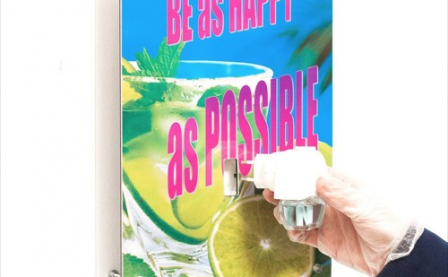Admittedly unhurried yet unusually productive, born-in-France Matthieu Levet has spent the last decade in Brussels like a night on the town. Riding tandem (Vermisst Susi, Carcass Identity) or solo (Carrageenan), Levet applies a two-instrument-maximum rule, paring down the body and soul of noise and techno into lean cuts. Returning the studio after back-to-back tours that relied heavily on public transit, he described through email how the pieces of the puzzle fit to complete his debut LP, Let’s Go There, released on the new imprint Cold Moss, which he runs out of Belgium.
You just got back from a bus tour and a tour right before that, correct? Any crazy anecdotes or revealing moments?
First tour was in Western Europe with Budapest-based Új Bála. We called it “Northern Exposure” as the idea was to go up to Helsinki, which sadly did not happen in the end. The Helsinki promoter didn’t like the warrior monkey on our tour poster for some reason and canceled the show.
Another highlight was when we carpooled from Warsaw to Prague. The driver from Kiev and his girlfriend took us for a random walk through the forest in search of some waterfall they had heard about. We found it but arrived three hours late in Prague.
Next tour was France and Switzerland with Christophe Clébard. Both tours were pretty insane, and I felt very lucky to have such great tour companions.
How were the shows? Are you from Brussels? Is it better to be home or away?
Switzerland is expensive to live in, but as a touring musician it’s kind of a paradise: great sound everywhere, warm and curious audiences, absinthe. France is also very good, especially now with this very active underground scene, but it’s my hometown, and I prefer tours to be more of an experience.
Also, with the political context we have in Western Europe at the moment (authoritarian liberalism?), I feel it’s more and more important to step out of our comfort zone and go against this divisive liberal vs. illiberal, I’m-the-good-boy narrative. In the Eastern European music scene especially, the vibe is pretty open and intense at the moment, and I always feel a great freedom playing when I’m touring in this area.
I’ve lived in Brussels for 10 years already. Touring, especially using public transport, is one of my favorite things in life. But it’s also physically demanding, and I’m usually happy to rest and go back to other things when I come back.
Care to share anything about the process of making Let’s Go There?
It was a pretty long process as I’m usually very slow (= years) to make decisions out of my recordings. The LP was built like a puzzle, and it took me a while to come up with the missing pieces, though some pieces were more evident. Closing track “Let’s Go There,’’ for example, is the oldest one, and it was always clear that it would be the exit of the album.
Your titles, e.g. “Serious Times,” “Empty Space,” “Let’s Go There,” are generic and universal, yet seem to complement your sound, while allowing the listener freedom to generate visual associations. How do you arrive at a song title?
Glad that you noticed. A title refers quite often to a precise moment of my life, with, sometimes, a second level of reference to a song, a book, an idea. “No One Told Me,” for example, is a song by John Lee Hooker. Once the title is found, the starting point is not important anymore. I just see it like a symbolic path for the listener to build his own narrative.
Your LP, down to Jonkie Moordkuil’s cover, is cohesive. How did you prepare for making this record?
All the tracks were built through improvisation, but generally nothing interesting happens without some kind of idea or intention at the core of the process.
Also, I would not call it preparation, but I have to admit that I recorded most of the songs in a triggered, tense, borderline yet focused state of mind.
Talking about the cover, it was also a long process, but I’m pretty happy with the result. I have known Jonkie M. for many years (we have a noise duo together called Vermisst Susi), and we have similar views on music and visuals.
John Philippakis describes your first three cassettes under the Carrageenan moniker as “minimalist noise.” How accurate is this description? How would you describe Carrageenan?
I always try to make the most out of a limited setup. My releases, including this LP, usually feature only one or two instruments plus the same amount of effects. Compared to proper noise or even techno, I try to keep some holes or lack of something in the sound.
Why is this project called Carrageenan?
Carrageenan is a seaweed. I liked the idea of a name that refers to a non-human lifeform, maybe because I have the feeling that humanity as we know it is pretty doomed. Carrageenan extract is a food additive mostly used as an emulsifier, but I found out recently it’s also used as an aphrodisiac in Jamaica.
What’s the story with Cold Moss?
Cold Moss is a place in Scotland. You can’t find it on Google Maps, but it exists, and it’s very cold and empty. Also, the other name of Carrageenan is Irish Moss.
More about: Carrageenan


